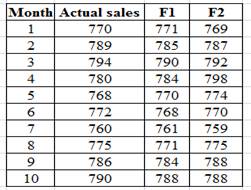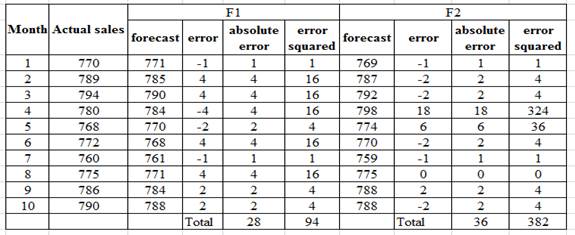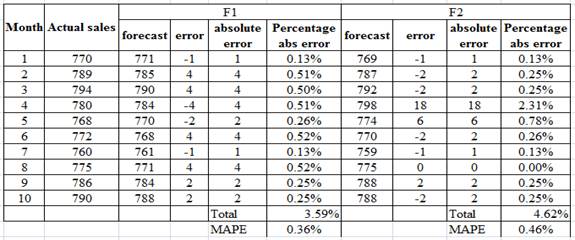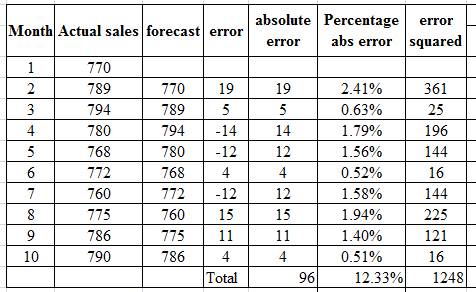
Concept explainers
Two independent methods of

a. Compute the MSE and MAD for each forecast. Does either forecast seem superior? Explain.
b. Compute MAPE for each forecast.
c. Prepare a naive forecast for periods 2 through 11 using the given sales data Compute each of the following: (1) MSE, (2) MAD, (3) tracking signal at month 10, and (4) 2s control limits How do the naive results compare with the other two forecasts?
a)
To compare: The MAD and MSE for two forecasts given below, including actual sales for 10 months.
Introduction: Mean Absolute Deviation (MAD) is the average distance between the data values and the mean. Mean Squared Error (MSE) is the average of the squares of the deviation and error.
Explanation of Solution
Given information:

Compute the MAD and MSE as shown below in the table:

Compute the Mean absolute deviation (MAD) for the forecasting method F1 as shown below
Substitute the value of
Compute the Mean squared error (MSE) for the forecasting method F1 as shown below
Substitute the value of
Compute the Mean absolute deviation (MAD) for the forecasting method F2 as shown below
Substitute the value of
Compute the Mean squared error (MSE) for the forecasting method F2 as shown below
Substitute the value of
The first forecasting method F1 gives both a low value of MAD as well as MSE compared to the second forecasting method F2
b)
To compute: Mean Absolute Percentage Error for both the forecasts F1 and F2 as shown below.
Introduction: Forecasting is the planning process that helps to predict the future demand using present or past data. It uses certain assumptions based the knowledge and experience of the management.
Explanation of Solution
Determine MAPE for both the forecasts:

The Mean absolute percentage error is lower at 0.36% for the first forecasting method F1 compared to MAPE of 0.46% for the second forecasting method F2
c)
To prepare: A naïve forecast.
Introduction: Forecasting is the planning process that helps to predict the future demand using present or past data. It uses certain assumptions based the knowledge and experience of the management.
Explanation of Solution
Determine MAD and MSE using a naïve forecast:
Use the naïve method for forecasting as shown below.

(i)
Compute the Mean absolute deviation (MAD) for the naïve forecasting method as shown below
Substitute the value of
(ii)
Compute the Mean squared error (MSE) for the naïve forecasting method as shown below
Substitute the value of
(iii)
Compute the tracking signal on the 10th month as shown below.
First compute the cumulative forecast error (CFE) as shown below
12.49=
Compute the tracking signal (TS) by dividing the cumulative forecast error by MAD as shown below.
(iv)
Given the Mean Squared Error is 156, the standard deviation σ is 12.49
The two sigma control limits are +2×12.49=24.98 and -2×12.49=–24.98
Since the tracking signal 1.87 falls between +24.98 and –24.98, the forecasting process is in control
The comparison of the naïve method with the other two forecasting methods is shown below.

Obviously the naïve method compares very poorly with the other two methods F1 and F2, since both the Mean Absolute Deviation (MAD) and Mean Squared Error (MSE) are worse than the other two methods.
Want to see more full solutions like this?
Chapter 3 Solutions
Operations Management
- The deaths are included in the discharges; this includes deaths occurring in less than 48 hours and postoperative deaths. Rehabilitation had 362 discharges, 22 deaths, 1<48 hours, 0 Postoperative. what is the gross death rate for the rehabilitation service?arrow_forwardA copy machine is available 24 hours a day. On a typical day, the machine produces 100 jobs. Each job takes about 3 minutes on the machine, 2 minutes of which is processing time and 1 minute is setup time (logging in, defining the job). About 20 percent of the jobs need to be reworked, in which case the setup time and the processing time have to be repeated. The remainder of the time, the equipment is idle. What is the OEE of the equipment?arrow_forwardHow do you think we can keep updating Toyota's ideas as new technologies come out and what customers want keeps changing?arrow_forward
- Given how TPS has helped change things in so many fields, do you think there are parts of it that might be hard to use in areas that aren’t about making things, like in healthcare or services? If so, why do you think that might be?arrow_forwardDo you feel there is anything positive about rework?arrow_forwardDo you think technology can achieve faster setup times? How would it be implemented in the hospital workforce?arrow_forward
- In your experience or opinion, do you think process changes like organizing workspaces make a bigger difference, or is investing in technology usually the better solution for faster setups?arrow_forwardHave you seen rework done in your business, and what was done to prevent that from occurring again?arrow_forwardResearch a company different than case studies examined and search the internet and find an example of a business that had to rework a process. How was the organization affected to rework a process in order to restore a good flow unit? Did rework hurt a process or improve the organization's operational efficiency? • Note: Include a reference with supportive citations in the discussion reply in your post.arrow_forward
- Setup time is very important in affecting a process and the capacity of a process. How do you reduce setup time? Give examples of reducing setup time. Please Provide a referenecearrow_forwardDo you think TPS was successful? If so, how? Are there other companies that have used TPS? If so, give examples. Please provide a referencearrow_forwardGiven the significant impact on finances, production timelines, and even equipment functionality, as you pointed out, what do you believe is the most effective single strategy a company can implement to significantly reduce the occurrence of rework within their operations?arrow_forward
 Contemporary MarketingMarketingISBN:9780357033777Author:Louis E. Boone, David L. KurtzPublisher:Cengage LearningMarketingMarketingISBN:9780357033791Author:Pride, William MPublisher:South Western Educational Publishing
Contemporary MarketingMarketingISBN:9780357033777Author:Louis E. Boone, David L. KurtzPublisher:Cengage LearningMarketingMarketingISBN:9780357033791Author:Pride, William MPublisher:South Western Educational Publishing Practical Management ScienceOperations ManagementISBN:9781337406659Author:WINSTON, Wayne L.Publisher:Cengage,
Practical Management ScienceOperations ManagementISBN:9781337406659Author:WINSTON, Wayne L.Publisher:Cengage, Purchasing and Supply Chain ManagementOperations ManagementISBN:9781285869681Author:Robert M. Monczka, Robert B. Handfield, Larry C. Giunipero, James L. PattersonPublisher:Cengage Learning
Purchasing and Supply Chain ManagementOperations ManagementISBN:9781285869681Author:Robert M. Monczka, Robert B. Handfield, Larry C. Giunipero, James L. PattersonPublisher:Cengage Learning



